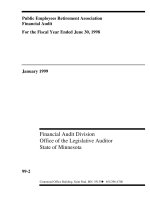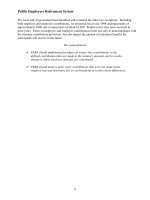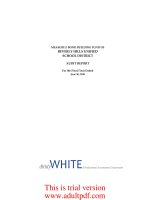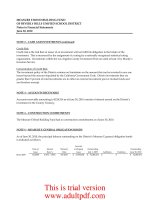Public Employees Retirement Association Financial Audit For the Fiscal Year Ended June 30, 1998 _part1 potx
Bạn đang xem bản rút gọn của tài liệu. Xem và tải ngay bản đầy đủ của tài liệu tại đây (49.13 KB, 11 trang )
Public Employees Retirement Association
Financial Audit
For the Fiscal Year Ended June 30, 1998
January 1999
Financial Audit Division
Office of the Legislative Auditor
State of Minnesota
99-2
Centennial Office Building, Saint Paul, MN 55155 651/296-4708
SUMMARY
State of Minnesota
Office of the Legislative Auditor
1st Floor Centennial Building
658 Cedar Street • St. Paul, MN 55155
(651)296-1727 • FAX (651)296-4712
TDD Relay: 1-800-627-3529
email:
URL:
Public Employees Retirement Association
Financial Audit
For the Fiscal Year Ended June 30, 1998
Public Release Date: January 15, 1999 No. 99-2
Agency Background
The Public Employees Retirement Association (PERA) administers pension funds that serve
approximately 220,000 county, school, and local public employees, their survivors and
dependents. Approximately 2,000 separate Minnesota government units participate in the
retirement funds administered by PERA. These units include counties, cities, townships, and
school districts.
The association administers three defined benefit funds. These funds provide retirement annuities
and survivor and disability benefits to members. PERA also administers a defined contribution
plan. The PERA Board of Trustees is responsible for administering these funds in accordance
with state statutes. The board has a fiduciary obligation to PERA's members, the employers, and
to the state. PERA assets at June 30, 1998, totaled approximately $13.3 billion for all of its
retirement plans.
Audit Objectives and Scope
The primary objective of our audit was to render an opinion on PERA's financial statements.
These financial statements are included in both PERA's and in the state of Minnesota's
Comprehensive Annual Financial Report for fiscal year 1998. Our objective included determining
whether PERA's financial statements presented fairly its financial position and results of
operations in conformity with generally accepted accounting principles.
As part of our work, we gained an understanding of the internal control structure and ascertained
whether PERA complied with laws and regulations that may have a material effect on its financial
statements. During our audit, we gained an understanding of the contributions, annuities, refunds,
Police and Fire Consolidation Fund mergers, and the financial statement preparation cycles.
Conclusions
PERA's Comprehensive Annual Financial Report for the year ended June 30, 1998, includes our
qualified audit opinion dated December 1, 1998. PERA’s financial statements were fairly
presented; however, we qualified our report because sufficient audit evidence did not exist to
verify PERA’s disclosures with respect to the year 2000. We do not provide assurance that
PERA is or will be year 2000 ready, that its year 2000 remediation efforts will be successful in
whole or in part, or that parties with which PERA does business will be year 2000 ready. PERA
designed internal controls to provide reasonable assurance that it properly administered its
material financial activities, except that management needs to ensure that contributions to the
Defined Contribution Plan are made in accordance with statutory specifications. PERA complied
with material financial legal provisions for the items tested, except for the contributions to the
Defined Contribution Plan.
Public Employees Retirement Association
Table of Contents
Page
Management Letter 1
Chapter 1. Background 3
Chapter 2. Contributions 7
Chapter 3. Annuities and Defined Contribution Refunds 11
Chapter 4. Police and Fire Consolidation Fund Mergers 13
Status of Prior Audit Issues 15
Public Employees Retirement Association Response 17
Audit Participation
The following members of the Office of the Legislative Auditor prepared this report:
Claudia Gudvangen, CPA Deputy Legislative Auditor
Jim Riebe, CPA Audit Manager
Sonya Johnson, CPA Auditor-in-Charge
Lori Kloos, CPA Auditor
Jason Stauffenecker Auditor
Mike Willis Auditor
Exit Conference
We discussed the results of the audit at an exit conference with the following PERA staff on
January 5, 1999:
Mary Most Vanek Executive Director
Dave DeJonge Manager of Finance
Gary Hovland Senior Accounting Supervisor
Senator Deanna Wiener, Chair
Legislative Audit Commission
Members of the Legislative Audit Commission
Members of the Public Employees Retirement Association
Mary Most Vanek, Executive Director
Public Employees Retirement Association
We have audited the financial statements of the Public Employees Retirement Association
(PERA) as of and for the fiscal year ended June 30, 1998, as further explained in Chapter 1. The
work conducted in the department was part of our Statewide Audit of the State of Minnesota's
fiscal year 1998 financial statements. We qualified our audit opinion, dated December 1, 1998, on
PERA’s Comprehensive Annual Financial Report for the year ended June 30, 1998. The financial
statements were fairly presented. Our report was qualified, however, because of uncertainties
about the potentially adverse affect the year 2000 computer issue may have on PERA’s
operations. Information technology experts believe that many computer applications in private
businesses and government may fail as a result of data integrity problems and erroneous
calculations beyond December 31, 1999. Sufficient audit evidence did not exist to verify PERA’s
disclosures with respect to the year 2000 issue. Because of the unprecedented nature of the year
2000 issue, its effects and the success of related remediation efforts will not be fully determinable
until the year 2000 and thereafter. The following Summary highlights the audit objectives and
conclusions. We discuss these issues more fully in the individual chapters of this report.
We conducted our audit in accordance with generally accepted auditing standards and the
standards applicable to financial audits contained in Government Auditing Standards, issued by
the Comptroller General of the United States. Those standards require that we obtain an
understanding of internal controls over financial reporting to plan the audit and to determine the
nature, timing, and extent of audit tests to be performed. The standards also require that we
design the audit to provide reasonable assurance of detecting noncompliance with provisions of
laws, regulations, contracts, and grants that have a direct and material effect on the financial
statements. The management of PERA is responsible for establishing and maintaining the internal
control structure and complying with applicable laws, regulations, contracts, and grants.
As part of obtaining reasonable assurance about whether PERA’s financial statements are free of
material misstatement, we performed tests of its compliance with certain provisions of laws,
regulations, contracts, and grants, noncompliance with which could have a direct and material
effect on the determinations of financial statement amounts. However, providing an opinion on
compliance with those provisions was not an objective of our audit, and accordingly, we do not
Public Employees Retirement System
2
express such an opinion. The results of our tests disclosed no instances of noncompliance that are
required to be reported under Government Auditing Standards.
In planning and performing our audit, we considered PERA’s internal control over financial
reporting in order to determine our auditing procedures for the purpose of expressing our opinion
on the financial statements and not to provide assurance on the internal control over financial
reporting. Our consideration of the internal control over financial reporting would not necessarily
disclose all matters in the internal control over financial reporting that might be material
weaknesses. A material weakness is a condition in which the design or operation of one or more
of the internal control components does not reduce, to a relatively low level, the risk that
misstatements in amounts that would be material in relation to the financial statements being
audited may occur and not be detected within a timely period by employees in the normal course
of performing their assigned functions. We noted no matters involving the internal control over
financial reporting and its operation that we consider to be material weaknesses. However, we
noted another matter involving internal control over contributions that is presented in Chapter 2.
This report is intended for the information of the Legislative Audit Commission and the
management of SBI. However, this report, which was released as a public document on
January 15, 1998, is a matter of public record, and its distribution is not limited.
James R. Nobles Claudia J. Gudvangen, CPA
Legislative Auditor Deputy Legislative Auditor
End of Fieldwork: December 1, 1998
Report Signed On: January 12, 1999
Public Employees Retirement System
3
Chapter 1. Background
The Public Employees Retirement Association (PERA) administers pension funds that serve
approximately 220,000 county, school, and local public employees, their survivors and
dependents. More than 2,000 separate Minnesota government units participate in the retirement
funds administered by PERA. These units include counties, cities, townships, and school districts.
The association administers the following defined benefit funds. These funds provide retirement
annuities and survivor and disability benefits to members.
Basic Plan Participants in this plan are public employees hired prior to January 1,
1968, who did not elect to be covered by social security benefits. This plan
is closed to new members.
Coordinated Plan Members in this plan include public employees other than police officers
and firefighters. Coordinated members are covered by social security
benefits.
Police and Fire Fund:Originally established for police officers and firefighters not covered by a
local relief association, the fund now covers all police officers and
firefighters hired since 1980.
Police and Fire
Consolidated Fund Legislation passed in 1987 allows local police and salaried firefighters'
relief associations to consolidate retirement programs with PERA. The law
requires the local relief associations to transfer all assets to PERA as of the
effective date of each merger. Two mergers took place during the fiscal
year ending June 30, 1998. As of June 30, 1998, 43 local relief
associations had consolidated with PERA.
PERA also administers a defined contribution plan. This plan is a tax-deferred retirement savings
program for elected public officials and public ambulance service personnel.
Agency Management
The PERA Board of Trustees is responsible for administering the retirement funds in accordance
with state statutes. The board has a fiduciary obligation to PERA's members, the employers, and
to the state. The board consists of ten members and the State Auditor. The Governor appoints
five of the members who serve four-year terms. These members represent cities, counties, school
boards, retired annuitants, and the general public. The PERA active membership elects the
remaining five trustees. One of these trustees must be a member of the Police and Fire Fund, and
one member must be a former member of PERA or a member who receives a disability benefit.
Public Employees Retirement System
4
The board appoints the executive director of PERA. Mary Most Vanek has been the executive
director since January 1997. With the approval of the board, the director develops the annual
administrative budget, determines staffing requirements, contracts for actuarial and other services,
and directs the day-to-day operations of the association. The executive director also is a member
of the State Investment Advisory Council. The council advises the State Board of Investment on
the management and investment of pension funds and other assets.
Financial Information
During the year ended June 30, 1998, PERA reclassified the Public Employees Defined
Contribution Plan (PEDCP) from an agency fund to a pension trust fund. This resulted in PERA
presenting a Statement of Changes in Plan Net Assets in fiscal year 1998.
For the three defined benefit pension funds administered by PERA, as well as the defined
contribution plan, Table 1-1 shows plan net assets at June 30, 1998, and Table 1-2 shows the
changes in plan net assets during fiscal year 1998.
Table 1-1
Statement of Plan Net Assets (in thousands)
as of June 30, 1998
Public Employees Police and Police and Fire Defined
Retirement Fund Fire Fund Consolidation Fund Contribution Plan
Assets:
Cash $ 656 $ 206 $ 12 $ 3
Accounts Receivable 1,221 139 4,697 0
Investments 4,109,953 1,939,636 478,880 12,276
Equity in Minnesota Post
Retirement Investment
Fund
5,239,332 778,461 764,431
Securities Lending Collateral 916,571 258,807 122,448 1,115
Fixed Assets (Net) 537 0 0 0
Total Assets $10,268,270 $2,977,249 $1,370,468 $,13,394
Total Liabilities $ 933,303 $ 262,952 $ 129,070 $ 1,172
Net Assets Held in Trust $ 9,334,967 $2,714,297 $1,241,398 $ 12,222
Note: Assets are reported at fair value.
Source: Condensed information from PERA's Comprehensive Annual Financial Report for the year ended June 30, 1998.
Public Employees Retirement System
5
Table 1-2
Statement of Changes in Plan Net Assets (in thousands)
for the Year Ended June 30, 1998
Public Employees Police and Police and Fire Defined
Retirement Fund Fire Fund Consolidation Fund Contribution Plan
Additions:
Member Contribution $ 140,386 $ 28,552 $ 3,733 $ 691
Employer Contribution 151,499 42,786 13,229 812
Net Investment Income 1,578,237 490,584 230,268 2045
Net Income from Securities
Lending Activity 3,313 941 442 3
Other Additions 1,382 193 24,222 0
Total Additions $1,874,817 $ 563,056 $ 271,894 $ 3,551
Deductions:
Benefits Paid $ 412,745 $ 56,034 $ 61,106 $ 0
Refunds of Contributions 16,922 1,182 296 520
Other 8,377 654 626 57
Total Operating Expenses $ 438,044 $ 57,870 $ 62,028 $ 577
Net Increase $1,436,773 $ 505,186 $ 209,866 $ 2,974
Net Assets Held in Trust, July 1, 1997 7,898,194 2,209,111 1,031,532 0
Adjustment for classification change 0 0 0 9,248
Net Assets Held in Trust, June 30, 1998 $9,334,967 $2,714,297 $1,241,398 $12,222
Source: Condensed information from PERA's Comprehensive Annual Financial Report for the year ended June 30, 1998.
Table 1-3 below highlights the funding ratios of the three defined benefit funds at June 30, 1998,
as reported by the consulting actuary for the Legislative Commission on Pensions and Retirement.
The purpose of an actuarial valuation is to test how the retirement system is achieving its
fundamental financing objectives and to determine the actuarial status of PERA's defined benefit
funds.
Public Employees Retirement System
6
Table 1-3
Defined Benefit Funds
Funding Ratios
June 30, 1998
Retirement Fund Name Funding Date Funding Ratio
Public Employees 2020 87.08%
Police and Fire 2020 134.22%
Police and Fire Consolidated 2010 104.13%
Source: Condensed information from the actuarial section of PERA's Comprehensive Annual Financial Report for the year
ended June 30, 1998. This funding ratio, based on the entry age normal actuarial cost method, is the ratio of assets
to actuarial accrued liabilities. According to statute, assets for this computation are valued at cost plus one-third of
the difference between cost and market values.
Audit Scope, Objectives, and Conclusions
The primary objective of our audit was to render an opinion on PERA's financial statements. Our
objective included determining whether PERA's financial statements presented fairly its financial
position and results of operations in conformity with generally accepted accounting principles. As
part of our work we gained an understanding of the internal control structure and ascertained
whether PERA complied with laws and regulations that have a material effect on its financial
statements.
Our audit focused on contributions, annuities, defined contribution plan refunds, and Police and
Fire Consolidation Fund mergers. We also reviewed investments and investment activity as
reported on the financial statements. The State Board of Investment (SBI) performs a significant
portion of the controls over PERA investments. We review the controls over state investments as
part of our annual audit of SBI.
To address our audit objectives, we interviewed key department employees, reviewed applicable
policies and procedures, and reviewed PERA's process for preparing its financial statements. We
tested representative samples of financial transactions and performed analytical procedures as we
considered appropriate. We also relied on the annual actuarial valuation performed by the
Legislative Commission on Pension and Retirement's actuary.
PERA's Comprehensive Annual Financial Report for the year ended June 30, 1998, includes our
qualified audit opinion dated December 1, 1998. PERA’s financial statements were fairly
presented; however, we qualified our report because sufficient audit evidence did not exist to
verify PERA’s disclosures with respect to the year 2000 computer issue. PERA’s financial
statements are also included in the State of Minnesota's Comprehensive Annual Financial Report
for the year ended June 30, 1998, which includes our audit opinion dated December 1, 1998.
Public Employees Retirement System
7
Chapter 2. Contributions
Chapter Conclusions
PERA's financial statements fairly presented employee and employer
contributions. Generally, PERA designed internal controls to provide
reasonable assurance that contributions were adequately safeguarded and that
transactions were authorized and properly reported in the accounting records
and financial statements, except that PERA did not design controls to ensure
that members of the Defined Contribution Plan contributed at the required
statutory rate. Except for Defined Contribution Plan contributions that were
not made at the required statutory rate, PERA complied with material financial
legal provisions for contributions tested.
PERA collects and processes contributions from participating counties, cities, townships, school
districts, and other public agencies. Employee and employer contribution rates are set in statute.
Employers also make additional contributions to cover unfunded liabilities. Similarly, Minn. Stat.
Section 353A.09, Subd. 5(b), requires cities whose relief associations have consolidated with
PERA to make an additional municipal contribution to amortize the unfunded liability of the relief
association at the time of consolidation. During fiscal year 1998 the contribution rates increased
for the Public Employees Retirement Fund. Table 2-1 shows contribution rates.
Table 2-1Retirement Plan Contribution Rates
Fiscal Year 1998
Employee
Contributions
Employer
Contributions
Additional
Employer
Contributions
7/1/97-
12/31/97
1/1/98 –
6/30/98*
7/1/97-
12/31/97
1/1/98 –
6/30/98*
7/1/97-
12/31/97
1/1/98 –
6/30/98*
Retirement Plan
Public Employees Retirement
Fund:
Basic Plan 8.23% 8.75% 8.23% 8.75% 2.50% 2.68%
Coordinated Plan 4.23% 4.75% 4.23% 4.75% 0.25% 0.43%
Public Employees
Police and Fire Fund 7.60% 7.6%
11.40%
11.40%
0.00% 0.00%
Police and Fire Consolidation Fund 7.60% 7.6% 11.40% 11.40%
(1) (1)
Defined Contribution Plan 5% 5% 5% 5% 0.00% 0.00%
* Contributions rate changes took effect the first full pay period after 1/1/98.(1) Additional lump sum municipal contribution as required by
MS 353A.09.
Source: Minnesota Statutes 353.27, 353.65, and 353A.09.
Public Employees Retirement System
8
Audit Objectives and MethodologyThe primary objectives of our audit were to answer
the following questions:
• Were employee and employer contributions presented fairly in PERA's financial
statements?
• Did PERA design and implement management controls to provide reasonable assurance
that contributions were adequately safeguarded and that transactions were authorized and
properly reported in the accounting records and financial statements?
• Did PERA comply with material financial legal provisions in administering contributions?
To answer these questions, we gained an understanding of the management controls over
contributions by interviewing PERA staff, reviewing policies and procedures, and determining if
the controls were implemented. We recalculated employee and employer contributions and
additional employer contributions as specified in statute for a sample of transactions. We also
performed analytical procedures on contribution amounts.
Conclusions
Contributions were fairly presented in PERA's financial statements. PERA also designed
and implemented internal controls to provide reasonable assurance that contributions were
adequately safeguarded. Contribution transactions were authorized and properly posted
to the appropriate units and member accounts and recorded in the proper funds, except
PERA did not ensure that members of the Defined Contribution Plan contributed at the
required statutory rate. We discuss that issue in Finding 1. We concluded that except for
employee and employer contributions to the Defined Contribution Plan, PERA complied
with material financial legal provisions for the contributions tested.
1. PERA did not have adequate controls to ensure that the Defined Contribution Plan
contributions were made at the specified statutory amounts.
PERA did not monitor employee and employer contributions to the Defined Contribution Plan
(DCP) to ensure that the contributions were made at the amount specified in statute. Minn. Stat.
Section 353D.03 Subd. 1 requires that eligible elected local government officials who participate
in the public employees Defined Contribution Plan shall contribute an amount equal to five
percent of their salaries. The governmental unit is required to contribute a matching amount to
the plan. PERA has responsibility to administer the plan in accordance with Minn. Stat. Chapter
353 D.
During our audit of contributions to the Defined Contribution Plan, we identified 100 out of a
total of 39,000 contribution transactions to the plan where participants had contributed either
more or less than the required five percent of gross salary. Contribution percentages for these
100 transactions ranged from 50 percent to one percent of the gross salary as compared to the
five percent statutory rate. We performed detailed tests on 22 of these 100 transactions. Of the
22 transactions tested, 20 were either above or below the required five percent of gross salary.









